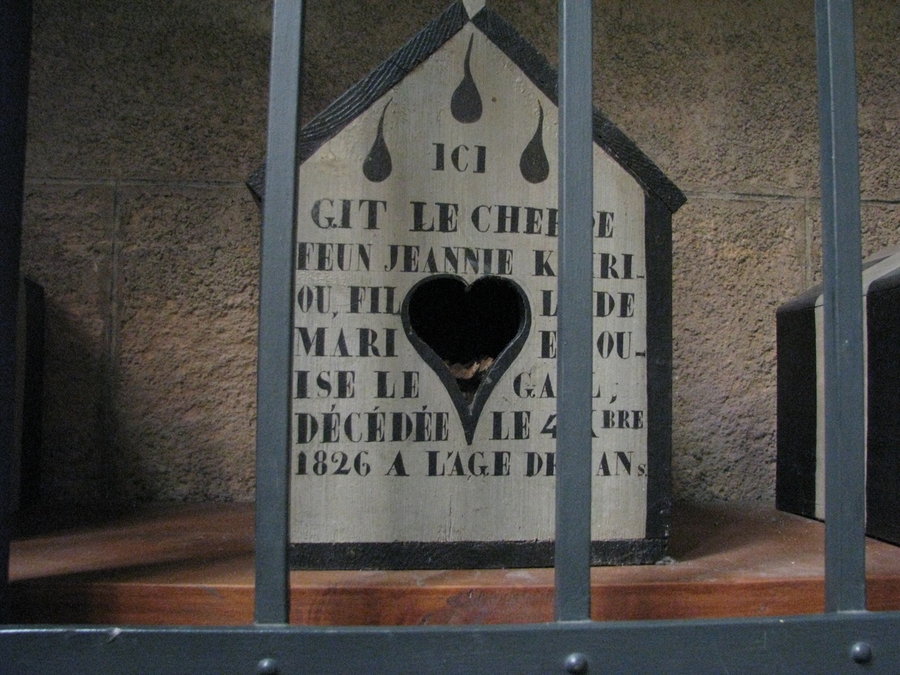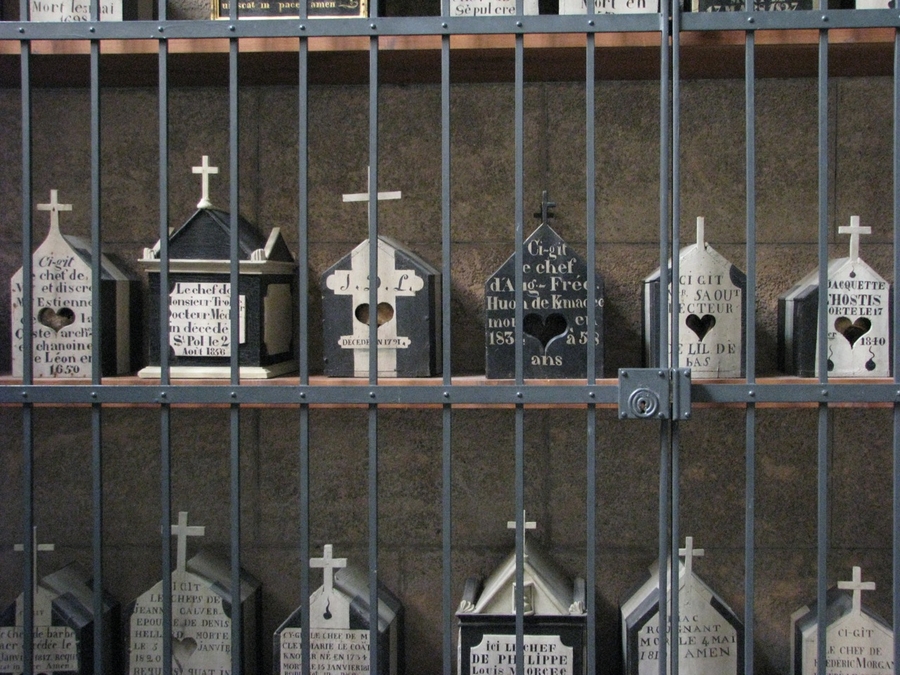Skull boxes that both memorialized a dead individual and displayed the deceased person’s skull were made in Brittany from the eighteenth century to about 1900. In Breton churchyards, prior to the First World War, the ossuary, or charnel house (located in the churchyard or attached to the church), was the receptacle of bones of the dead taken from graves in the crowded churchyard. Because of very limited consecrated ground, this might happen as soon as five years after the initial burial. After a grave was exhumed, the skull was separated from the other bones and put in a wooden box shaped like a peaked-roof house; this was painted (by travelling artisans or cemetery workers) with the name of the dead and dates of life and age at death. The contained skull remained partially visible through a heart-shaped opening. The box was then placed in the church or in an ossuary niche where it functioned as a miniature tomb that both memorialized the departed individual and displayed the material remains of the deceased.
Throughout France, during the medieval period, there was little emphasis on the literal site that the material body of the deceased occupied. Generally speaking, mass graves in the churchyard were used for the burial of those not important enough to merit placement under the paving stones of churches. By the fifteenth century, especially in Brittany, ossuaries came into use for the storage and display of older bones when plots in crowded burial grounds were reused. In the seventeenth century, official pressure was exerted by church hierarchy and local clergy to end the burial of all but the clergy and aristocracy within the sanctified space of the church. However, in western Brittany, where the cult of the dead was strongest, this practice was resisted the longest. Even before Breton communities switched from burying under the church’s interior pavement to churchyard burials, official French concerns for hygiene in the 1790s encouraged the further removal of cemeteries from village centers to the edges of populated areas. Travelers in Brittany throughout the nineteenth century found skull boxes to be archaic, barbaric, or primitive, yet the making and saving of the skull box was a relatively recent, local response to the nature of death in Brittany. Although asserting “modernity” for this practice may seem inherently contradictory, this object and its materiality functioned as a conduit for memory that resisted the earlier anonymity of burial.

In 1896 Breton folklorist Charles Le Goffic explained that in Breton practice the term “relics” (reliques) referred to bones of the dead, without making a distinction between the ordinary and the sanctified. A skull box, like a reliquary, displays its contents, but it is not an object that implies or promises a spiritual crossing over into the world of the miraculous. In making a representational image or object of human remains, in sorting and tidying and framing them, skull boxes can be understood as a sort of memory-object, refashioned from the body, like many nineteenth-century mourning objects made from hair. Yet unlike a mourning picture, crafted of hair, and destined for domestic display, a skull box, no matter how well painted or constructed, is unavoidably literal and utilitarian in its function of marking the presence and memory of the departed individual. Rather than understanding these boxes as archaic or primitive things, the Breton skull box might be regarded as a local, particularizing, modernizing practice of individual commemoration, that opposed mingling the material traces of the dead in the unmarked collective ossuary. In Brittany, where many skull boxes predate carved stone monuments in adjacent cemeteries, these decorated receptacles can be read as local precedents for modern practices of memorializing the individual in death.
Notes
Imprint
10.22332/con.obj.2014.24
1. Maura Coughlin, "Skull Boxes," Object Narrative, in Conversations: An Online Journal of the Center for the Study of Material and Visual Cultures of Religion (2014), doi:10.22332/con.obj.2014.24
Coughlin, Maura. "Skull Boxes." Object Narrative. In Conversations: An Online Journal of the Center for the Study of Material and Visual Cultures of Religion (2014). doi:10.22332/con.obj.2014.24



